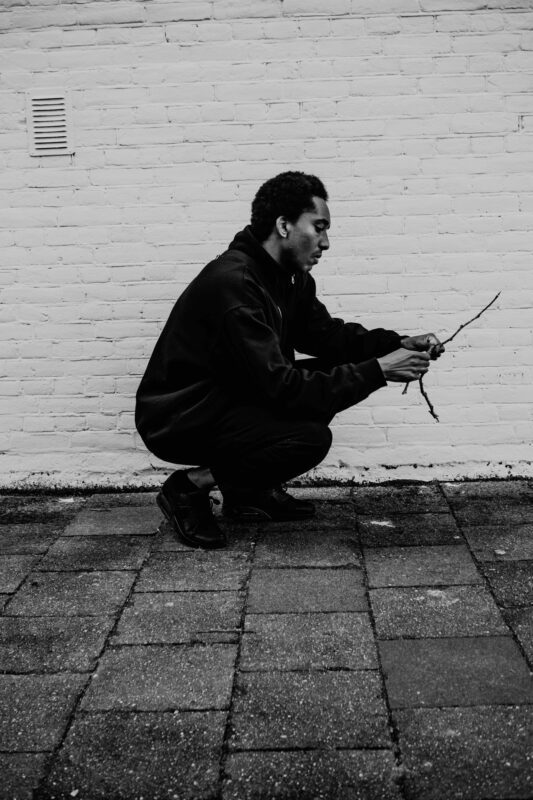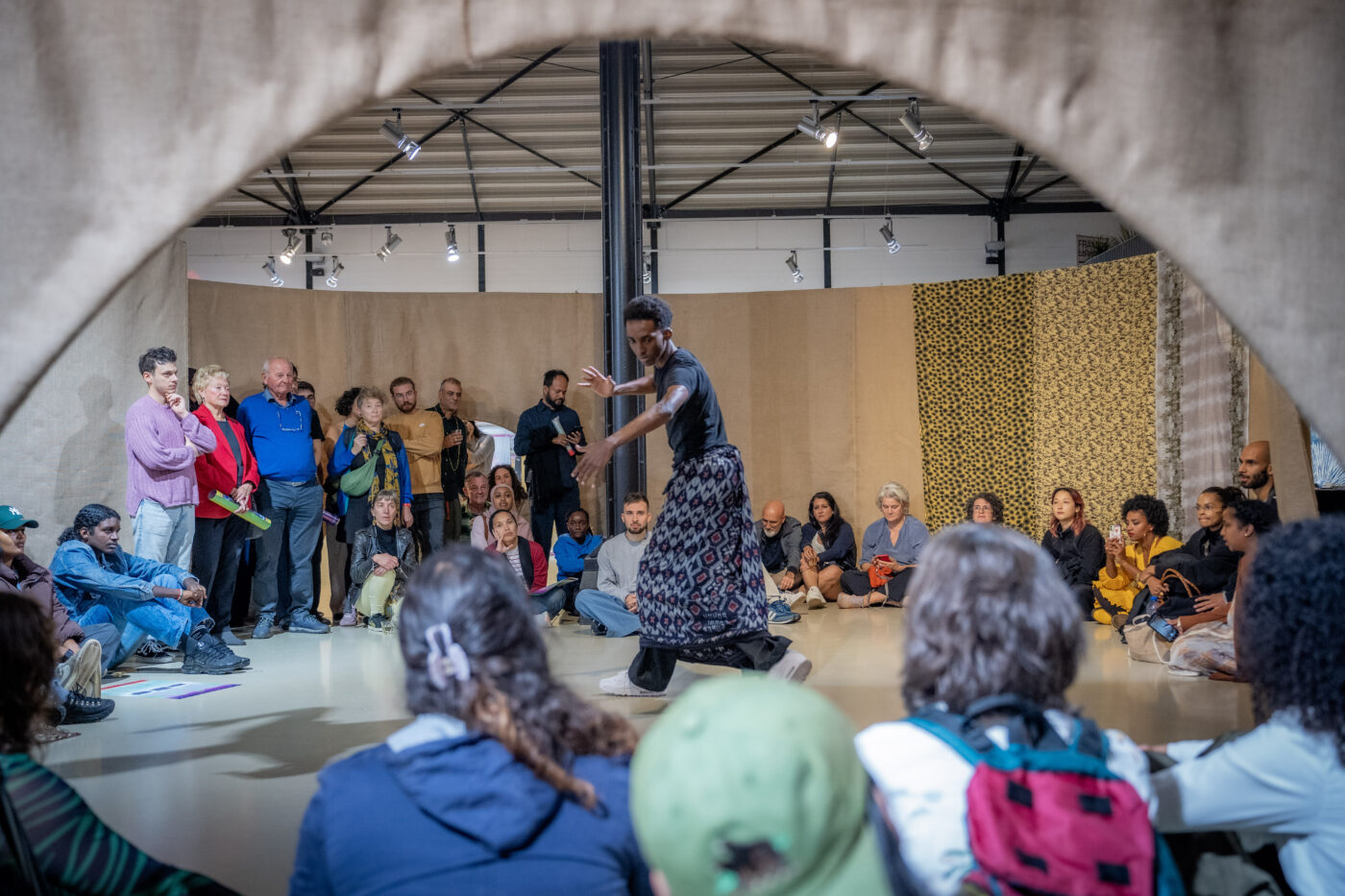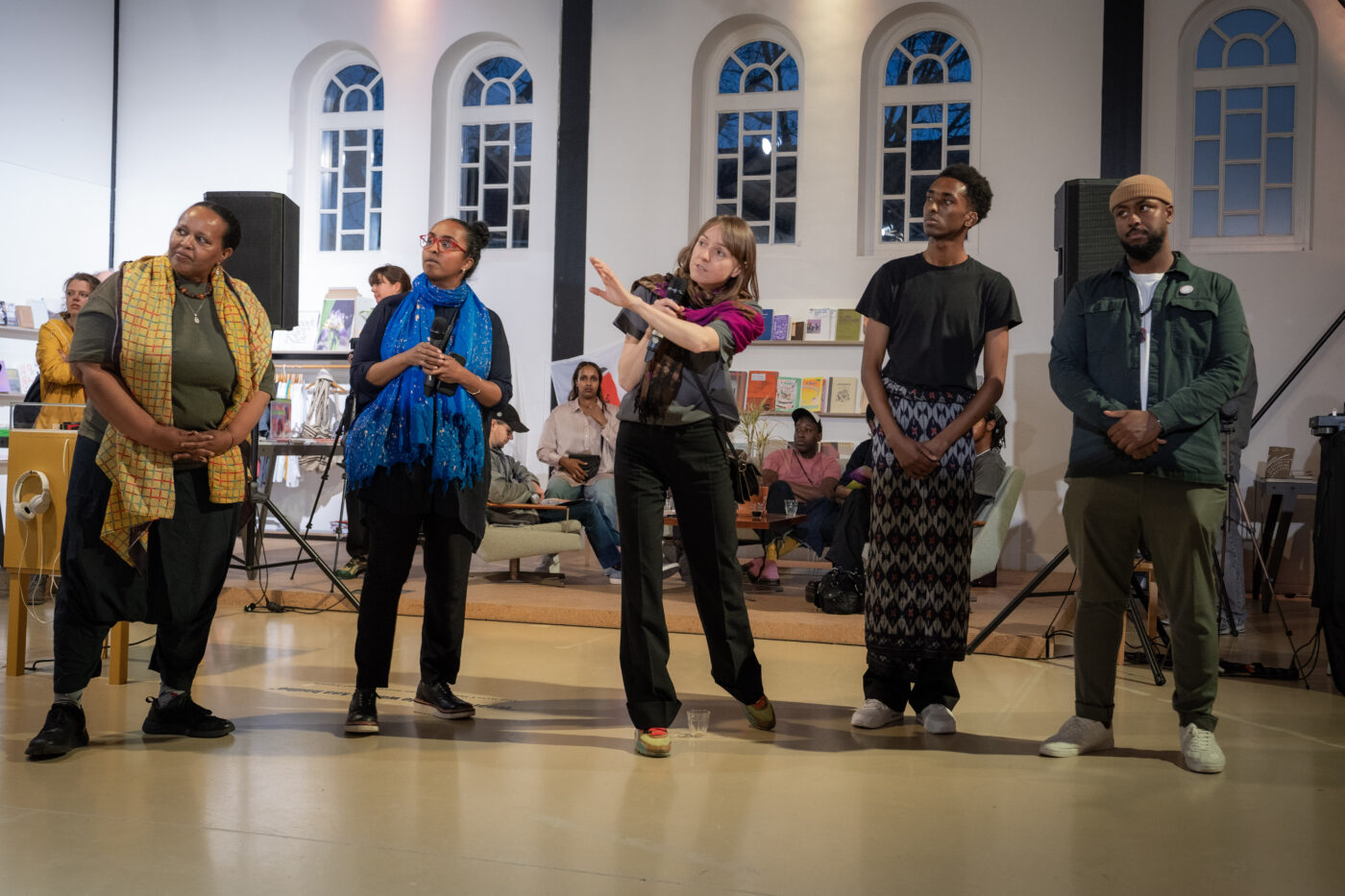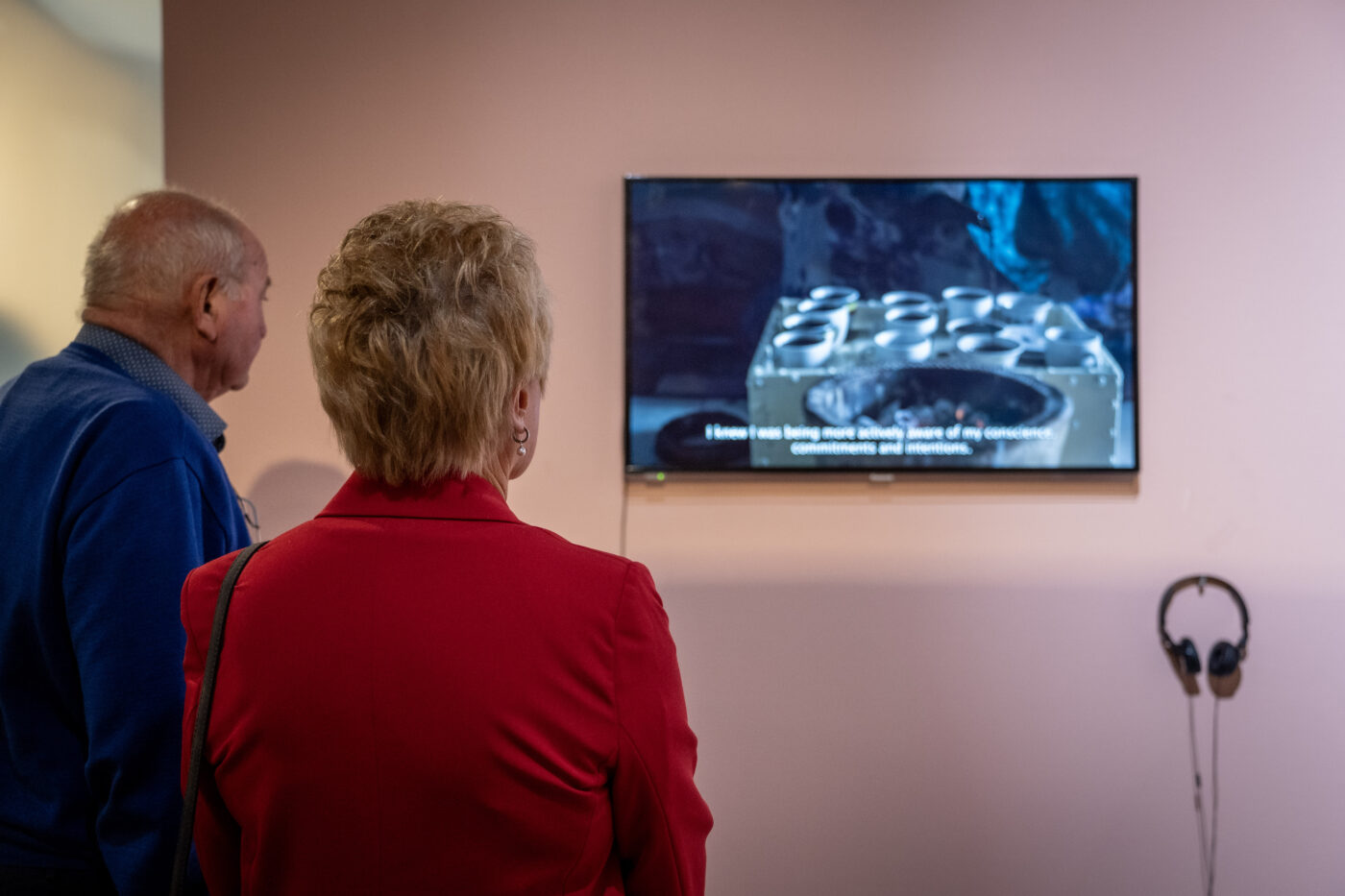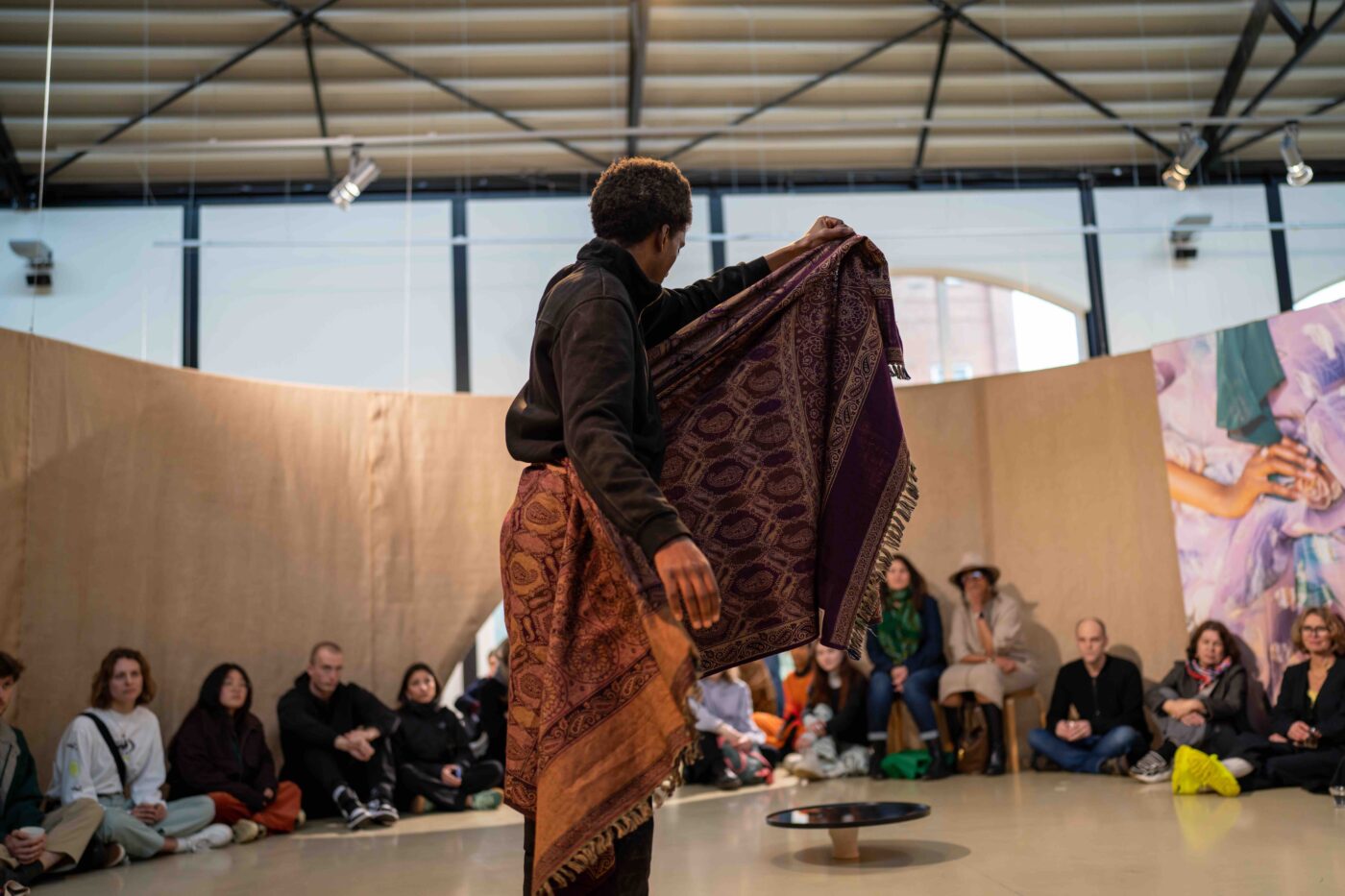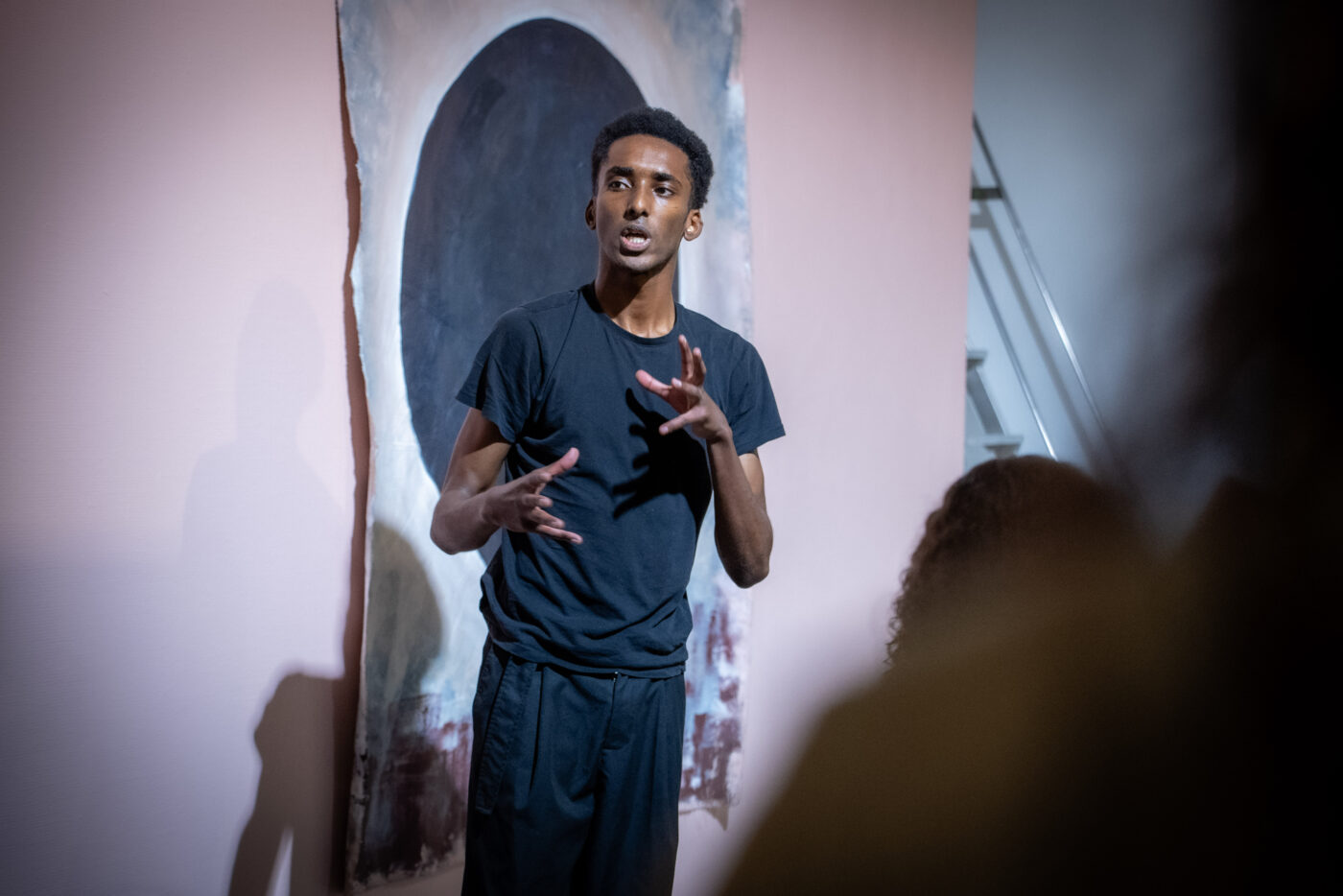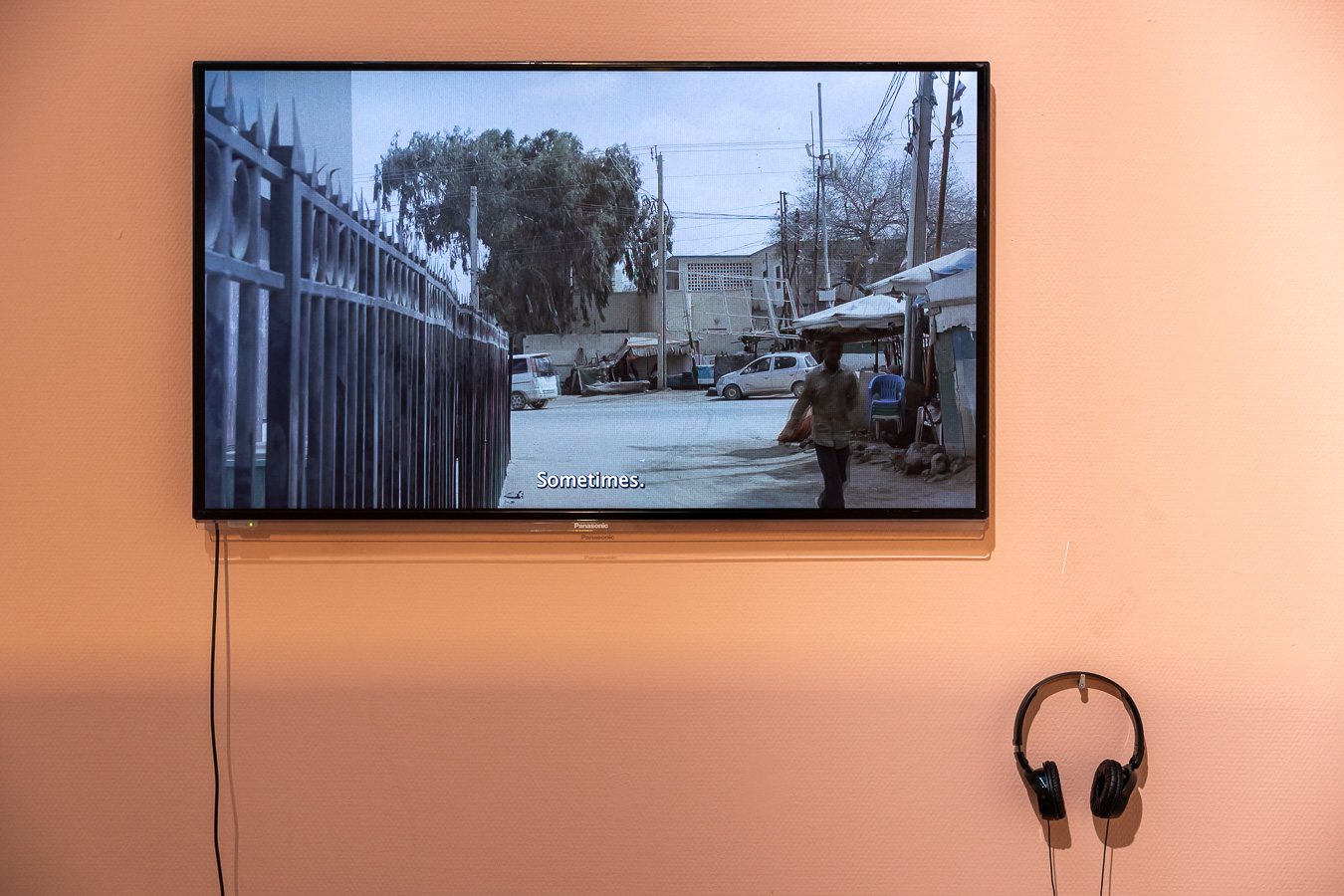Salman Dirir: Een persoonlijke en artistieke ontdekking
Salman Dirir is a multidisciplinary artist and filmmaker based in the Netherlands, with Somali and Djiboutian heritage. He was born and raised in Eindhoven and has a background in audiovisual production. His work spans various forms of artistic expression, including filmmaking, dance, music, and visual arts, often exploring themes related to biculturality, identity, and the immigrant experience. Dirir is known for combining surrealism and expressionism in his artistic approach, using feeling and intuition as key drivers in his creative process. His projects, such as the short films Caadi and RUUN, explore complex cultural narratives, often inspired by his Somali heritage. His ongoing work, RUUN, investigates indigenous Somali culture and the nuances of collective identity through field research in Somaliland.
He participated in the group exhibition titled The Anarchist Citizenship: People Made of Stories (2024-2025), where he was showcasing his short film RUUN. To understand his journey and motivations better. We asked Dirir several questions about his work and influences.
Text by Idil Samatar
To start, how were you introduced to The Anarchist Citizenship?
I was introduced to The Anarchist Citizenship (TAC) project through Amal Al-haag. She invited me to take part in the TAC as we had been in contact before. Recently, I have found myself greatly inspired by Amal and her work. Specifically, what she is doing to address certain issues, and how to unpack things I am going through myself as someone who is Black and born here in the Netherlands.
RUUN as you have described it, is an artistic and personal investigation where you explore your truths. Can you share what truths you were uncovering?
How I relate to my Somali heritage is personal and something I can only define for myself. Taking this into account, I am navigating by constantly redefining what I perceive as true. This exploration of what this journey meant to me has been shaped by questioning: How do I see myself as, how did I see myself, and how has this changed over time? What do I want to learn more about? It remains a constant reflection. It is very common to have a colonised mind growing up in the Netherlands. On a subconscious level, I started to internalise the gaze of the environment in which I was raised. That is something I have been trying to unpack since I was 19, to this day. The unpacking of these effects are the ‘truths’ I have been uncovering.
RUUN is a very raw and unpolished version and a work in progress. It came from a place of feelings and thoughts — though mainly feelings that I can reflect on because it felt honest, though it was unpolished. The project is a means to resist the erasure of our cultural heritage. This is to prevent the knowledge and information of our ancestors from being lost.
To honour our arts and encourage myself and others of the Somali diaspora to preserve our culture and arts. For that, I have to give a shout-out to Idel Rasheed and Ibrahim Xirsi of the Instagram page WaaberiPhone. It helped me with finding more artistic and Somali sources.
The Anarchist Citizenship: People Made of Stories features your short film RUUN, can you please walk us through your artistic direction for this film?
The whole project was a study of our Somali indigenous culture. Indigenous, perhaps everywhere on earth, can be a loose term because cultures always get influenced from outside.
RUUN came about during a period where I was deeply invested in African indigenous knowledge systems. From a quirky 8-year-old kid obsessed with Ancient Egypt and reading about its connection with the Puntites in 2015 to getting immersed in the ‘free-spirited/counter-culture”’ currents. Mainly because of musical heroes like such as J Dilla and Madlib, thatwhom I grew up listening to, who would take samples from the wholeentire world. This has sparked my curiosity for digging and collecting, which made me appreciate, and explore sound, texture and culture. To Afro surrealists like Sun Ra and Alice + and John Coltrane, which from whom I draw inspiration from when I attempt to ‘sculpt’ with time.
During my upbringing in the Somali community, it felt as if I did not learn about our dhaqan (culture) that much besides apart from our aroos (weddings), language and food. Reflecting back on it, I realise now that’s no It isn’t necessarily true, ; it just wasn’t quite that clear. However, I do think there was some sort of distancing of our arts because of certain interpretations of Islam. It stillWhich then led me to the following questions: What part of ‘our’ cultural practices did I not know of and what was is there still to be explored? It made me dig into sources that wrote about this, and from as a result of this, I came across the book Divine Fertility by Sada Mire in 2020. I read it and felt I had some sort of compass that could help me navigate the intuitive direction I wanted to take. It resulted in me visiting Hargeisa and Berbera for the first time in 2022 and 2024.
The artistic direction is the rough journey of my research. I went into it like a dance, there is some thought and substance to it but most of it was me attempting to be honest with myself. And, from there let my intuition follow.
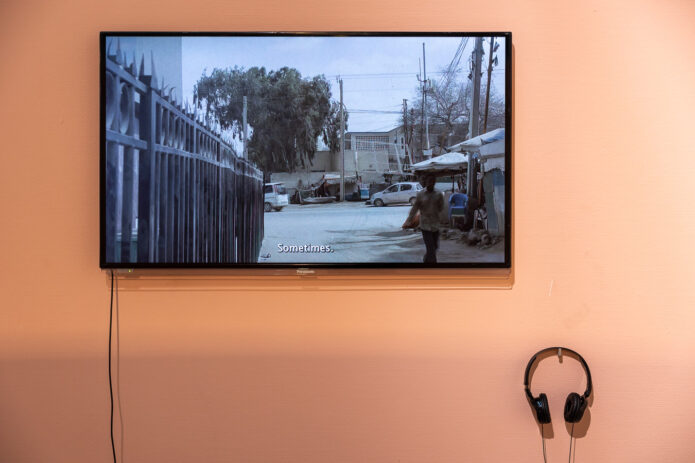
Installation photo of RUUN (2024) by Salman Dirir from the exhibition The Anarchist Citizenship: People Made of Stories (2024-2025) at Framer Framed, Amsterdam. Photo: Maarten Nauw / Framer Framed
Your short film opens with ‘How do traces from the past shape the present?’. How do you feel that traces from the past shape the present, and how does this theme play out in your short film?
The main feeling is the fact that I am based here in the Netherlands and a part of the first generation born and raised here. It became clear to me that it is not as obvious and typical as I grew up thinking it was. So, coming back to unpacking, this means also digging into the past to understand how that shapes the present. In many ways, for instance, the film itself does not speak much about the past but everything linked to it. The best example is the opening shot where you see Laas Geel, and the whole area surrounding Laas Geel. The area is ancient and the cave paintings are one of the oldest in the world. Furthermore, the soil was remarkable to me as it was very distinct from the soil in and surrounding the city. It all breathes something ancient and perhaps untapped. The stories I shared about cultural norms and their relativity are also tied to both the past and the present. Yet, time does not work linearly, and that is what I felt subconsciously and spiritually. I felt a sense of timelessness which I am still processing. It mainly had to do with the day-to-day life rhythm of the locals which seemed more natural compared to here in the West. Where time is money and everything has to be calculated, often at the cost of what we’re trying to cherish.
Throughout your film you showcase images from Somaliland, what was your experience visiting Somaliland?
Reconnecting with my family and experiencing local life enriched me in ways money can’t measure. It felt like rediscovering a part of myself. The spices, frankincense, incredible food, and warmth of the people made my time exceptional. Which made me seriously consider moving to Somaliland one day. I acknowledge my male privileges and recognise that my experience differs from that of a woman. It would have its own nuances, even if still lovely. It was clear I could navigate with ease as a man compared to being a woman. I must say my young aunt was bold and knew how to handle disrespect from males, which was both amusing and confronting at the same time. However, I recognised that I must have had a distorted image prior to entering the country. I was surprised by the extent of the conditioning to which I had been subjected, and this became clear over time.
A good example is the currency exchange that happens outside the markets of Hargeisa where the exchange has a pile of thousands of US dollars on the ground and leaves it unattended when they pray. No one would monitor to ensure there wasn’t anyone stealing. It showed that on some level it was safer in Hargeisa than Eindhoven.
In your short film, there are references to Somali proverbs and phrases mentioned such as ‘Aqoon l’aan waa iftin l’aan’ meaning ‘the absence of knowledge is the absence of light’. What significance do traditional Somali proverbs and phrases have to you, and how do they influence your art?
I saw the quote from the Instagram page Waaberiphone years ago and it stuck with me. I never knew about it beforehand. It resonated with me strongly because I see understanding as light when navigating through life.
In your short film, you blend filmmaking with dance as forms of expression — what inspired you to merge these two art forms, and how do they enhance the storytelling?
I was trying things out—breathing, observing, moving. It all began as research. Not to sound lazy, but I didn’t formally secure funding for this film, so I hustled while working on a commercial and attending workshops at Hargeisa Cultural Centre. I accepted that I could document things and experiment since I lacked resources. You see me breathing, moving, and observing the essence of that moment. I reached out to Abdillahi Persia through Mohammoud Siad, my Somali film teacher in the Netherlands, and my cousin Abdi, and I shot at Laas Geel. I’d like to return and redo it; this was just a sketch.
On the opening night, you danced while utilising the space of the exhibition moving through the crowd and the artwork. Seeing some of your dancing included traditional Somali dance moves. What was the intention behind this performance, and how did incorporating Somali dance movements contribute to the themes of your film and exhibition?
To be honest, not everyone might appreciate this answer but I got inspired by God, spirits, ancestral veneration and trance. It is based partly on the research I conducted in Somaliland on the Somali dance styles, Dhaanto, Jhaander and Saylici. I read in an interview by one of the bands Waaberi and Dur-Dur members, Sahra Dawo and Abdulahi Shariif Hassan. To paraphrase the article by the Vinyl factory, “what defined Dur Dur’s sound was the inclusion of two singers Dawo and Hassan who was an expert in Somalia’s traditional music. ‘I was particularly interested in Saar, a frenetic type of music intended to summon the spirits during religious rituals’.” For me, it can mean raising energy, or transmuting energy though used for something good. For example, releasing repressed energy through dancing. Similar to Buraanbur and Sitaad ceremonies
In Divine fertility it is argued that Saar has – possibly – been a stage in the rituals associated with sacred fertility. I want to note – personally – beforehand as a way to resist and counter attacks on cultural heritage that ritual to some puritanical can be seen as shirk, yet I’d like to confront them that art itself is ritual. I read that Wahabism has been used as a tool to erase our Indigenous institutions. And if that’s correct I wonder if it has been deliberately used with the proxy wars Somali people have been subjugated to with the intent to destabilise the region. In that case I want to encourage other Somali’s the revival of these elements as a way to empower and shield ourselves. Which ties to my on-going research.
My performance was an attempt to meditate — observe — and move in that process. I tried to be as honest as possible and transmute what I felt, which are emotions and thoughts. The mirror represents my commitment to seeing things as they truly are, not as I wish them to be. With this all I wanted to share my personal exploration of our arts. A fusion of my breakdancing and hip-hop background and my Somali heritage.
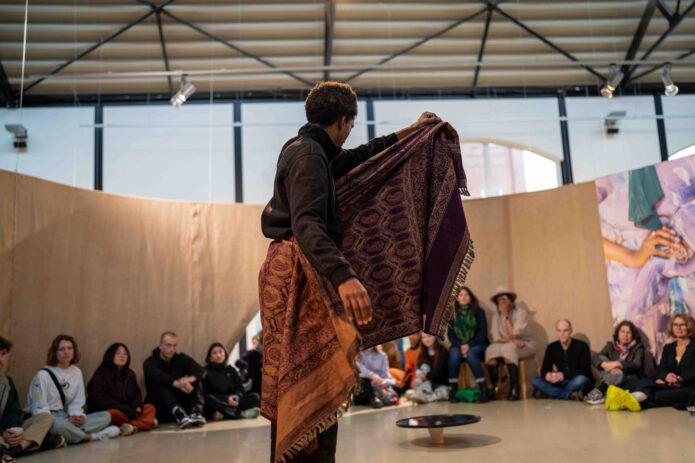
Salman Dirir performing at the finissage of the exhibition The Anarchist Citizenship: People Made of Stories (2024-2025) at Framer Framed, Amsterdam. Photo: © Hemanth Madupu / Framer Framed
Performance / Diaspora /
Exposities
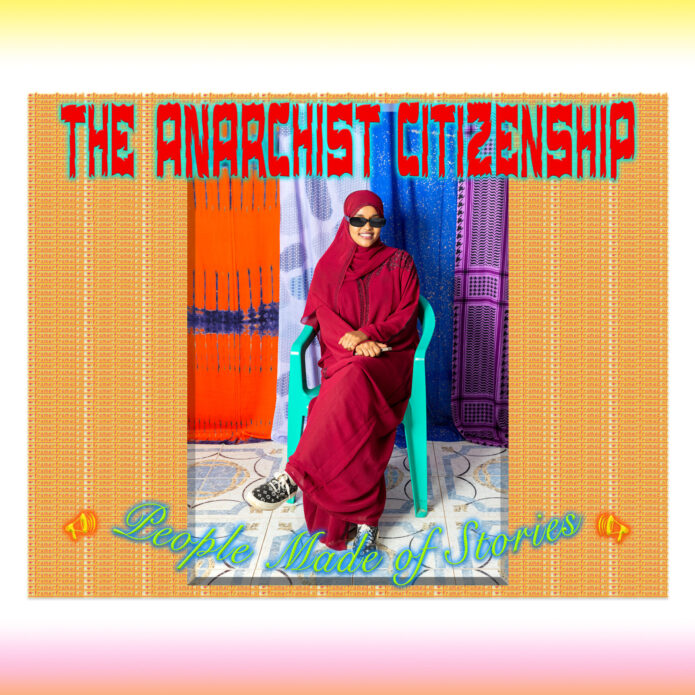
Expositie: The Anarchist Citizenship – People Made of Stories
Deze tentoonstelling onderzoekt hoe storytelling en beeldcultuur de sociale structuren in Somaliland, de Somalische regio en de diaspora burgerschap vormgeven
Agenda
Finissage Weekender – The Anarchist Citizenship: People Made of Stories
Op zaterdag 25 en zondag 26 januari 2025 sluit Framer Framed de tentoonstelling The Anarchist Citizenship: People Made of Stories af met een weekend vol performances, muziek en gesprekken.
Opening The Anarchist Citizenship: People Made of Stories
Opening van de tentoonstelling die onderzoekt hoe storytelling, beeldcultuur, architectuur en de sociale structuren in Somaliland, de Somalische regio en de diaspora burgerschap vormgeven
Netwerk
